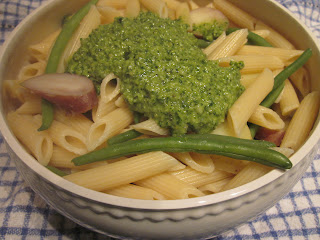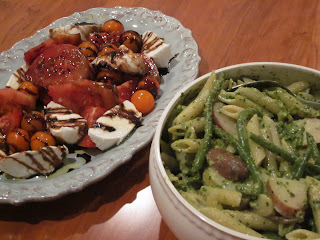Basil Pesto: An Italian Kitchen Staple
When traveling through Italy, treat your senses by entering a neighborhood deli. These little grocery stores sell freshly prepared food—mostly made in-house—that you can take away with you. Of course, you might prefer to enter a full-fledged large chain grocery store if you’d rather have more anonymity with limited—or non-existent—Italian. The mom-and-pop operations are infinitely more charming, but also a bit more daunting, with the promise (or threat, depending on your Italian and social proclivities) of personal interaction.
In either case, if you have a kitchen you can use during your travels, you can make a lovely “home-cooked” meal with a few items from these grocery stores simply and quickly prepared—or assemble a picnic with cheeses, fruits, bread, and wine. One item that I always wished I could take back with me in vast quantities was pesto. Not the jarred kind with oil already separated from the herbs. Not even those “fresh” pestos we get at our grocery stores that have a plastic freshness seal on top. No, the heavenly light-green Genoa pesto scooped up with a spoon and put into a little container for your dinner tonight—not next week or next month.
Ever since I saw a mound of pesto in a Vernazza deli (in Cinque Terre), I have tried various different pesto recipes to duplicate the fullness of flavor somehow packed into the almost mousse-like texture. Many recipes call for adding parsley to prevent darkening of the pesto, but I found the parsley also added a little bitterness (and, besides, the pesto wouldn’t get darker if I ate it right away, right?). Some recipes try to make me feel guilty if I don’t want to mortar-and-pestle this sauce. But that process—no doubt authentic a hundred years ago—didn’t seem to produce the lightness of texture. I started to suspect that contemporary grandmothers in Italy actually were not pounding away tons of pesto in their unwieldy mortar and pestle. So, while I occasionally use a knife to “rough chop” my pesto, my preferred method is the food processor.
The recipe that best resembles the pesto I enjoyed in Vernazza and Siena is a variation on the pesto recipe from Williams-Sonoma’s Mastering Pasta, Noodles, and Dumplings.
Recipe:
1 cup packed basil leaves
3 tbs pine nuts (Note: Pine nuts being rather expensive, you can substitute walnuts.)
2 cloves garlic
¼ tsp salt (or more to taste)
¼ cup extra-virgin olive oil
3 oz. finely grated Parmigiano-Reggiano or Grana Padano cheese
1. Place basil, nuts, garlic, and salt in the bowl of a food processor (a mini-processor is fine for this small batch of pesto). Pulse several times to finely grind and combine.
2. Pour a thin stream of olive oil through the lid of the processor with the motor running. Keep processing or pulsing until the color is a fairly uniform bright green.
3. Once the consistency and color is to your liking (a bit darker green than you’d like eventually), scrape mixture from the food processor into a medium bowl. Add most of the grated cheese and stir to combine. Taste for seasoning and adjust with salt and cheese. At this point, the pesto should be a little saltier and more flavor-packed than you might expect since you will be adding pasta (and/or other ingredients) later. In color, it should be a light but vibrant green with specks of darker green of the basil.
Note: Keep in mind that you are not “cooking” pesto the way you would a tomato sauce. Instead, you reserve some hot pasta cooking water and add that with your pesto to the dish. The pesto will stick to the pasta rather than being thinner, like some other sauces. I like to serve pesto pasta with a plate of tomatoes, buffalo mozzarella, and balsamic glaze. If you don’t have balsamic glaze, come back for another post on that other lovely staple for your Italian kitchen.






Comments
Post a Comment